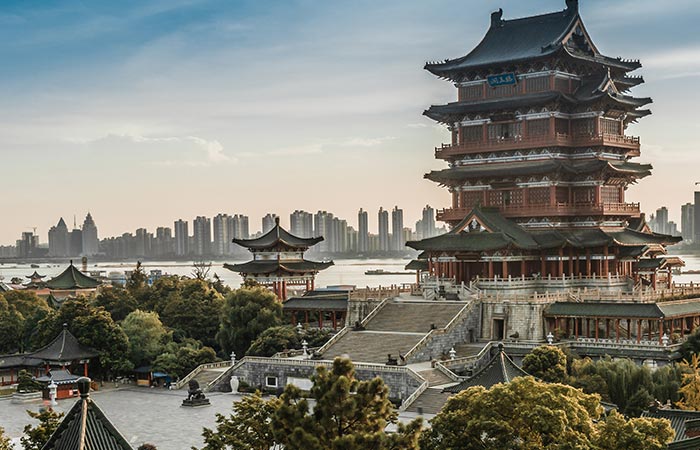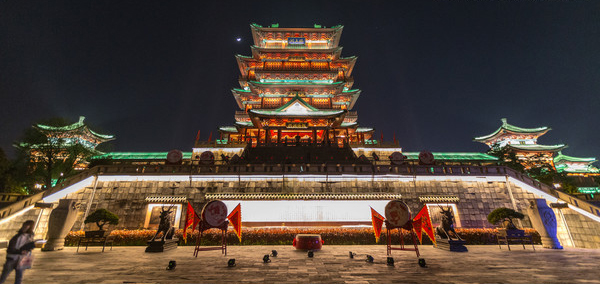Tengwang Pavilion
3 min readThe Tengwang Pavilion , located on the east bank of the Ganjiang River, northwest of Nanchang City, Jiangxi Province, is one of the three most notable pavilions south of the Yangtze River together with Yellow Crane Tower and Yueyang Pavilion. It also has the reputation of being “the First Pavilion of Xijiang River”due to its excellent location, height, overall size, and architectural style.

The reputation of Tengwang Pavilion,to a great extent,is due to a well-known prose-Preface to Tengwang Pavilion by Wang Bo.It is said that when the author,a reputable poet of the Tang,passed Nanchang on his way to Guangdong,he wrote this prose on the subject of the banquet which was being held to celebrate the reconstruction of the Pavilion.With the spread of this prose,Tengwang Pavilion became proverbial.
The Pavilion was built in 653 A.D.,when Tengwang LiYuanying,a younger brother of Emperor Taizong of the Tang Dynasty,was the military governor of Nanchang.The Pavilion was named after him but it had undergone reconstruction as many as 28 timesasa consequence of events during its 1,300 year-long history.In 1926,the Pavilion was destroyedby fire during the conflicts between the Northern Warlords and as a result,the building was burned to ashes and only the bluestone plaque”Tengwang Pavilion”remained.The current building,based on the style of architecture in the Song Dynasty,is the result of rebuilding that was carried out between 1983 and1989.

The existing pavilion is even more spectacular and magnificent than its predecessors.The main building is 57.5 meters in height and occupies a construction area of13,000 square meters with a 12-meter-long base symbolic of ancient city walls.Taking the two-storey basement into account,it has nine storeys,that is,three bright,three dark and one top.
The six floors of the Pavilion treasure scores of artistic writings each with a theme relevant to the exhibition there.On the first floor there is a huge white marble relief”Timely Wind Sending Wangbo to Tengwang Pavilion”which is drawn based on the story that Wangbo composed Preface to Tengwang Pavilion.The second floor is a dark floor on which stands a 2.55-meter high and 20-meter long wall-painting named”Pictures of Outstanding Figure”with all the renowned celebrities from Qin Dynasty to Ming Dynasty.The third floor is a bright floor surrounded by cloister.The pictures here are wall-painting”Linchuan Dream”and a huge bronze relief which depicts the dancers in the Tang Dynasty,reflecting a prosperous and peaceful look of the Tang Dynasty.The fourth floor,a dark floor,houses a large mural”The Rich Land”describing the beautiful mountains and streams in Jiangxi Province from southtonorth:the Mei Pass of Da Yu Mountain,the magnificent Guifeng Mountain,the Dragon and Tiger Mountain-the birthplace of Taoism,the Chinggang Mountain-the cradle of the Chinese Revolution,the Lu Shan Mountain,the Po Yang Lake-the largest freshwater lake in the country,the Stone Bell Hill-an important military pass in the ancient time,etc.The fifth floor is the ideal place for enjoying the scenery and meeting friends.The paintings such asPlaying Long Flute to Make Phoenix Coming,Waiting for Boat at the Foot of Xi Mountain drawn by Huang Qiuyuan,Preface to Tengwang Pavilion,a calligraphic work by Su Dongpo on a bronze stele,and a lacquer painting One hundred Flowers and One Hundred Butterflies are placed.The sixth floor is actually the ninth floor if counting the basements,so it is called”the Ninth Level Heaven”.On the walls of north,south and east,there is a tri-colored glazed wall painting Dance Troupe in Tang Dynasty.








